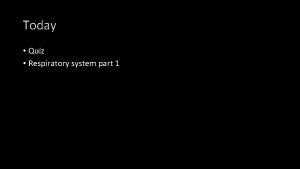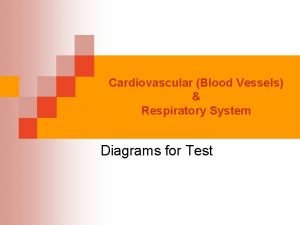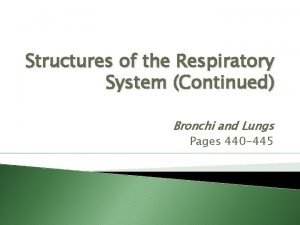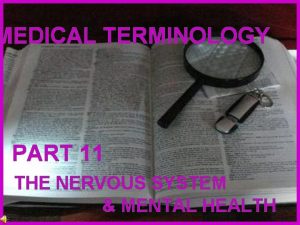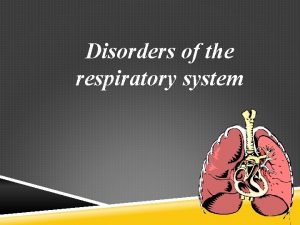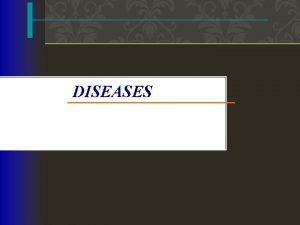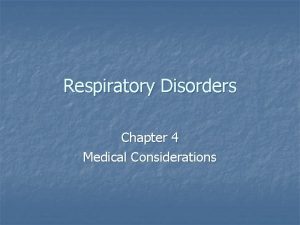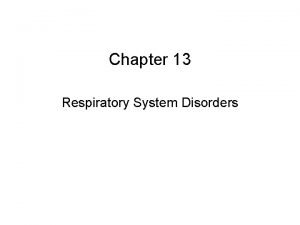Disorders of the respiratory system Respiratory structures such














- Slides: 14

Disorders of the respiratory system

Respiratory structures such as the airways, alveoli and pleural membranes may all be affected by various disease processes These respiratory diseases include: 1. Infections such as pneumonia. 2. Obstructive disorders that obstruct airflow into and out of the lungs such as asthma, bronchitis and emphysema. 3. Restrictive disorders are conditions that limit normal expansion of the lungs such as pneumothorax, atelectasis, respiratory distress syndrome and cystic fibrosis. 4. Cancers or exposure to Inhaled particles alter the pulmonary function.

GENERAL SYMPTOMS OF RESPIRATORY DISEASE ¯Hypoxia : Decreased levels of oxygen in the tissues ¯Hypoxemia : Decreased levels of oxygen in arterial blood ¯Hypercapnia : Increased levels of CO 2 in the blood ¯Hypocapnia : Decreased levels of CO 2 in the blood ¯Dyspnea : Difficulty breathing ¯Tachypnea : Rapid rate of breathing ¯Cyanosis : Bluish discoloration of skin and mucous membranes due to poor oxygenation of the blood

RESPIRATORY INFECTIONS Infections of the respiratory tract can occur in: 1. The upper respiratory tract or 2. The lower respiratory tract, or 3. Both. Organisms capable of infecting respiratory structures include: 1. bacteria. 2. viruses: the majority of upper respiratory tract infections are caused by viruses as rhinovirus and parainfluenza virus. 3. fungi. Depending on the organism and extent of infection, the manifestations can range from mild to severe and even life threatening.

OBSTRUCTIVE RESPIRATORY DISORDERS Bronchial asthma Asthma is a condition characterized by reversible bronchospasm and chronic inflammation of airway passages. The incidence of asthma has been steadily increasing in recent years. Although the exact etiology is still uncertain, there appears to be a definite genetic predisposition to the development of asthma. A key component of asthma appears to be airway “hyper reactivity” in affected individuals. Exposure to certain “triggers” can induce marked bronchospasm and airway inflammation in

Obstructive Respiratory Disorders Bronchial asthma Individuals with asthma appear to produce large amounts of the antibody Ig. E that attach to the mast cells present in many tissues. Exposure to a trigger such as pollen will result in the allergen-binding mast cell-bound Ig. E, which in turn causes the release of inflammatory mediators such as Histamine , Leukotrienes and Eosinophilic Chemotactic factor. The response of a patient with asthma to these triggers can be divided into an “early phase” and a “late phase. ”

Obstructive Respiratory Disorders Bronchial asthma **Some Potential Asthma Triggers** Allergens — Pollen, pet dander, fungi, dust mites Cold air Pollutants Cigarette smoke Strong emotions Exercise Respiratory tract infections


Obstructive Respiratory Disorders Bronchial asthma Clinical Classification of Asthma Mild intermittent : Attacks occur 2 times per week or less Mild persistent : Attacks occur more than 2 times per week Moderate persistent : Attacks occur daily or almost daily and are severe enough to affect activity Severe persistent : Attacks are very frequent and persist for a long period of time; attacks severely limit activity

Obstructive Respiratory Disorders Bronchial asthma Manifestations of asthma : û Coughing, wheezing û Difficulty breathing û Rapid, shallow breathing û Increased respiratory rate û Excess mucus production û Significant anxiety

Obstructive Respiratory Disorders Bronchial asthma Treatment of asthma: The appropriate drug treatment regimen for asthma is based on the frequency and severity of the asthma attacks and may include the following: 1. Avoidance of triggers, and allergens. Improved ventilation of the living spaces, use of air conditioning. Bronchodilators (examples: albuterol, terbutaline): Short acting β-Adrenergic receptor activators. May be administered as 2. needed in the form of a nebulizer solution using a metered dispenser or may be given subcutaneously. These drugs block bronchoconstriction response. but do not prevent the inflammatory

Obstructive Respiratory Disorders Emphysema is a respiratory disease that is characterized by destruction and permanent enlargement of terminal bronchioles and alveolar air sacs Terminal bronchiole Alveolar duct Respiratory bronchioles septum alveoli NORMAL ACINUS

Obstructive Respiratory Disorders Emphysema Well over 95% of all patients with emphysema were chronic cigarette smokers. Although the exact etiology of emphysema is still uncertain, Chronic exposure to cigarette smoke causes chronic inflammation of the alveolar airways, which results in infiltration by lymphocytes and macrophages. Excess release of protease enzymes such as trypsin from lung tissues and leukocytes can digest and destroy the elastic walls of the alveoli. Levels of a protective enzyme α-1 -antitrypsin have been shown to be lacking in certain individuals who are chronic cigarette smokers. This enzyme inactivates destructive protease enzymes (trypsin) in lung tissue. In fact, a rare form of emphysema occurs in individuals who are not cigarette smokers but who have a genetic lack of α-1 -antitrypsin.

PHYSICAL ACTIVITY IN ASTHMA Breathing exercises Breathing against resistance, Diaphragmatic breathing Stretching (trunk and neck region) Mm. Pectorales M. trapezius Mm. scaleni M. sternocleidomastoid Strengthening exercises Mm. Rhomboidei Deep flexors of neck Aeorbic exercises (become less sensitvite to dyspnea) Interval exercises Relaxation techniques
 Conducting zone of the respiratory system function
Conducting zone of the respiratory system function Circularory system
Circularory system Art-labeling activity: figure 13.2
Art-labeling activity: figure 13.2 5 functions of the respiratory system
5 functions of the respiratory system Labeled
Labeled Respiratory zone structures
Respiratory zone structures Alveolar ducts
Alveolar ducts Analogous structures
Analogous structures How respiratory system work with circulatory system
How respiratory system work with circulatory system Circulatory system and respiratory system work together
Circulatory system and respiratory system work together Chapter 6 musculoskeletal system
Chapter 6 musculoskeletal system Chapter 17 reproductive system diseases and disorders
Chapter 17 reproductive system diseases and disorders Chapter 15 nervous system diseases and disorders
Chapter 15 nervous system diseases and disorders Disorders of the nervous system
Disorders of the nervous system Chapter 8 cardiovascular system
Chapter 8 cardiovascular system


